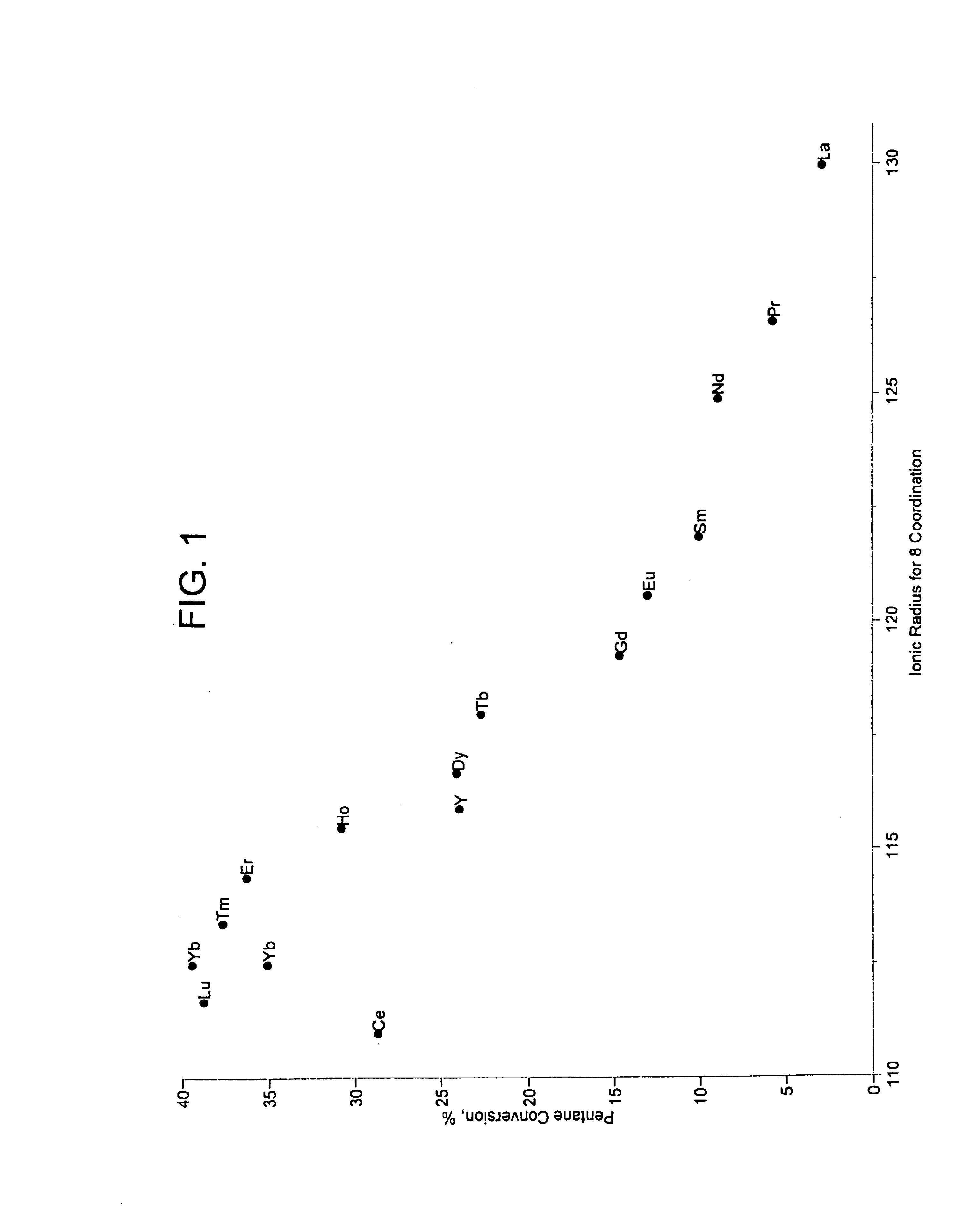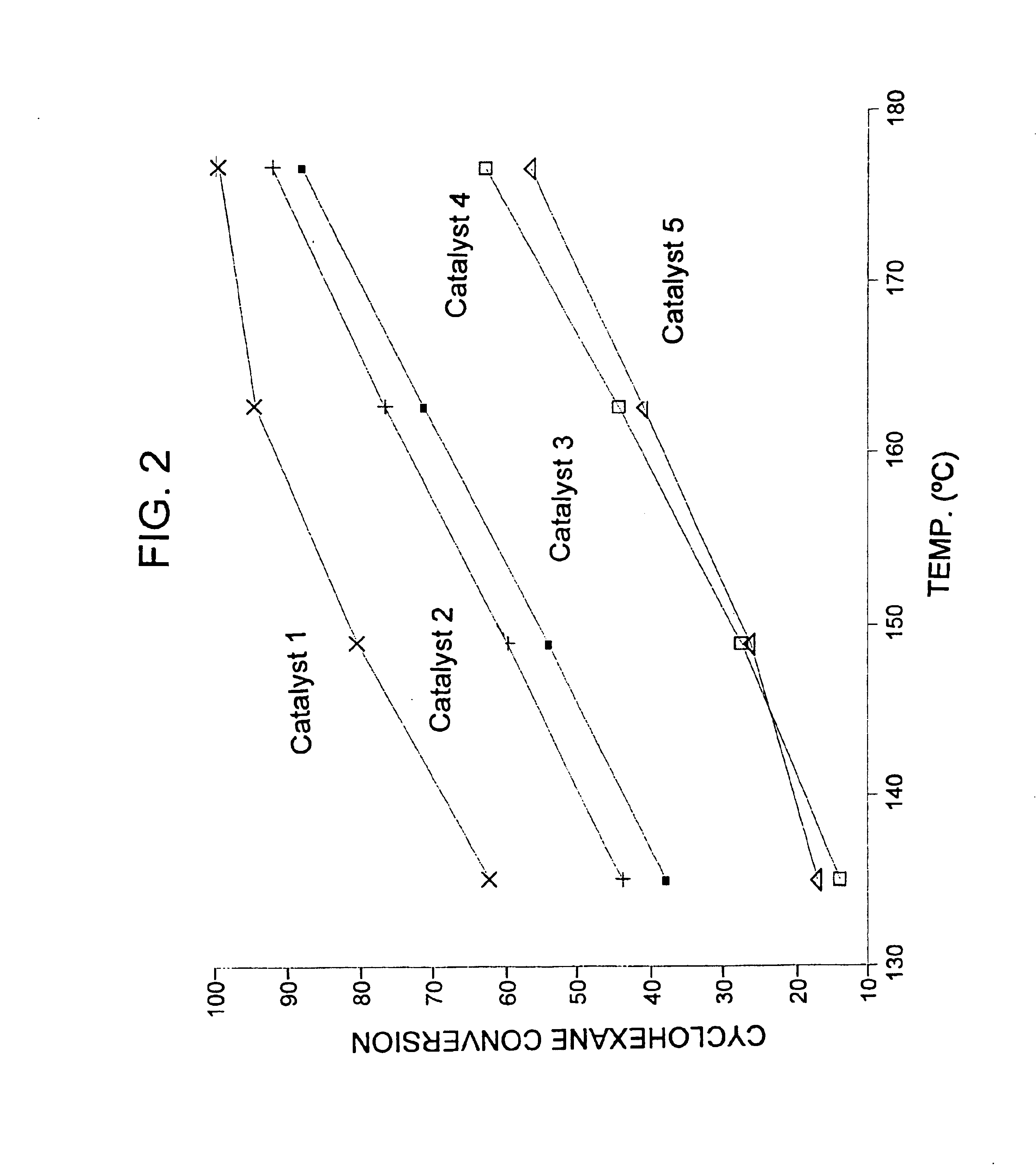High-activity isomerization catalyst and process
a high-activity isomerization and catalyst technology, applied in catalyst activation/preparation, metal/metal-oxide/metal-hydroxide catalysts, chemical/physical processes, etc., can solve the problems of unfavorable reduction of platinum-group metal, patent disclosure of additional metal components of catalysts, and reduced catalyst efficiency. , the effect of improving catalyst and process
- Summary
- Abstract
- Description
- Claims
- Application Information
AI Technical Summary
Benefits of technology
Problems solved by technology
Method used
Image
Examples
example 1
[0039]Catalyst samples of Table 1 were prepared starting with zirconium hydroxide that had been prepared by precipitating zirconyl nitrate with ammonium hydroxide at 65° C. The zirconium hydroxide was dried at 120° C., ground to 40-60 mesh. Multiple discrete portions of the zirconium hydroxide were prepared. Solutions of either ammonium sulfate or a metal salt (component 1) were prepared and added to the portions of zirconium hydroxide. The materials were agitated briefly and then dried with 80-100° C. air while rotating. The impregnated samples were then dried in a muffle oven at 150° C. for two hours under air. Solutions of either ammonium sulfate or a metal salt (component 2, where component 2 is not the same as component 1) were prepared and added to the dried materials. The samples were briefly agitated and dried while rotating. The samples were then calcined at 600-700° C. for 5 hours. The final impregnation solutions of chloroplatinic acid were prepared and added to the solid...
example 2
[0041]Catalysts were prepared as described in Example 1 containing 2 wt. % modifier, 0.4-wt. % platinum, and 7-wt. % sulfate. Approximately 95 mg of each sample was loaded into a multi-unit reactor assay. The catalysts were pretreated in air at 450° C. for 2-6 hours and reduced at 200° C. in H2 for 0.5-2 hours. 8 wt. % pentane in hydrogen was then passed over the samples at 150° C., approximately 1 atm, and 2.5 hr−1 WHSV (based on pentane only). The products were analyzed using online gas chromatographs and the results are shown in FIG. 1, note that a replicate of the ytterbium-containing catalyst was tested. FIG. 1 is a plot of percent pentane conversion vs. the ionic radii for 8 coordination of the lanthanide series or yttrium materials used to modify a platinum sulfated zirconia catalyst. The ionic radii were determined by reference to Huheey, J. E. Inorganic Chemistry—Principles of Structure and Reactivity, 2nd Ed.; Harper & Row: New York, 1978. The plot shows a maximum conversi...
example 3
[0042]Catalysts were prepared as described in Example 1, with the first catalyst (Catalyst 1 in FIG. 2) containing 3 wt. % ytterbium, about 0.375 to about 0.4 wt. % platinum, and 7 wt. % sulfate; the second catalyst (Catalyst 2 in FIG. 2) containing 1 wt. % ytterbium, about 0.375 to about 0.4 wt % platinum, 1 wt. % iron, and 6 wt. % sulfate, and the third catalyst (Catalyst 3 in FIG. 2) containing 0.5 wt. % manganese, 1 wt. % iron, about 0.375 to about 0.4 wt % platinum and 7 wt. % sulfate. Additionally, two reference catalysts were obtained, the first reference catalyst containing platinum on sulfated zirconia (Catalyst 4 in FIG. 2), and the second reference catalyst containing platinum, iron, and manganese on sulfated zirconia (Catalyst 5 in FIG. 2). Approximately 10.5 g of each sample was loaded into a multi-unit reactor assay. The catalysts were pretreated in air at 450° C. for 2-6 hours and reduced at 200° C. in H2 for 0.5-2 hours. Hydrogen and a feed stream containing 36 wt. %...
PUM
| Property | Measurement | Unit |
|---|---|---|
| temperature | aaaaa | aaaaa |
| temperature | aaaaa | aaaaa |
| temperature | aaaaa | aaaaa |
Abstract
Description
Claims
Application Information
 Login to View More
Login to View More - R&D
- Intellectual Property
- Life Sciences
- Materials
- Tech Scout
- Unparalleled Data Quality
- Higher Quality Content
- 60% Fewer Hallucinations
Browse by: Latest US Patents, China's latest patents, Technical Efficacy Thesaurus, Application Domain, Technology Topic, Popular Technical Reports.
© 2025 PatSnap. All rights reserved.Legal|Privacy policy|Modern Slavery Act Transparency Statement|Sitemap|About US| Contact US: help@patsnap.com



